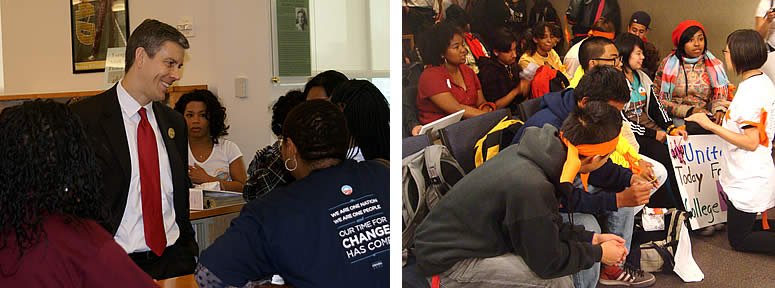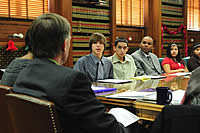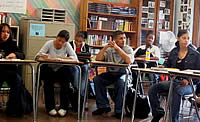
by Julie Kippenbrock, 16, and Jake Thornburgh, 16, of Y-Press
Ever since school was made compulsory for American children in the early 20th century, efforts at reform rarely included input from youth. But that is changing, as U.S. institutions are beginning to value the opinions of youth, and as youth themselves have realized their collective power through new networking media.
Click here to read these profiles:
Californians for Justice“Ten years ago, it was hard for young people, or adults even, to know whom to lobby, to find which elected officials, let alone to figure out how to contact them. And with all that information readily available online, I think the bar is lowering on how difficult it is to do lobbying at the same time that interest is rising among young people to do lobbying,” said Thaddeus Ferber, manager of the Youth Policy Action Center an online youth empowerment site organized by a collection of youth and advocacy organizations around the country.
Youth activism on educational issues takes many forms. It includes volunteering within the school to help staff or students. It also includes fundraising for various school projects and programs and lobbying administration officials for changes in policy or curriculum.
Other forms of activism happen outside of school. Youth write letters or launch rallies to press elected officials and administrators for changes they believe in. They also attend board meetings and city council meetings to present their cases for reform.
Youth councils
One of the biggest shifts in the past ten years is the presence of youth on policy-making boards. Many institutions are realizing that youth need to have input on policies that concern them.
 “We’ve seen a rise in the number of youth councils that have been created across the country, where a mayor or a governor or a state legislature creates an advisory board of young people who they call on to provide recommendations on the policies that are being developed to affect their lives,” said Ferber, who also serves as program director at the Forum for Youth Investment, a nonprofit “action tank” that specializes in youth development.
“We’ve seen a rise in the number of youth councils that have been created across the country, where a mayor or a governor or a state legislature creates an advisory board of young people who they call on to provide recommendations on the policies that are being developed to affect their lives,” said Ferber, who also serves as program director at the Forum for Youth Investment, a nonprofit “action tank” that specializes in youth development.
Nicole Yohalem also is a program officer at the Forum. She agrees with Ferber that the rise in youth involvement at the policy level is significant.
“I think more adults in communities and inside of institutions like schools, and inside of government, would acknowledge that it’s important to have young people’s voices in the mix,” she said. “I don’t think it’s shifted as much as it should, and I think there’s still a lot of people who would nod their head and say, ‘Yeah, that’s important,’ but then turn around and shut the young person down in a meeting. But I do think there’s been progress.”
Pairing activism with new technology
But while sitting on policy boards is important, grassroots youth activism, where youth identify a problem in their schools and communities and work to fix it, are the most common—and inclusive—form of activism. Across the nation, youth raise funds for school programs they value, like sports and language clubs, and they counsel their peers about health, violence and lifestyle concerns. They protest standardized testing and lobby for more test prep and internship opportunities. They press lawmakers for more funding by taking photos, writing letters and holding rallies, and they appeal to city and school officials for help with safety and transportation issues.
 New technology has been a boon to activism of all kinds. Not only does it help youth find pertinent information related to a cause, but they can use it to disseminate that information quickly and widely. In addition, social networking sites, such as Facebook and MySpace, have been extremely useful tools for organizing events and lobbying influential individuals.
New technology has been a boon to activism of all kinds. Not only does it help youth find pertinent information related to a cause, but they can use it to disseminate that information quickly and widely. In addition, social networking sites, such as Facebook and MySpace, have been extremely useful tools for organizing events and lobbying influential individuals.
“Now you can instantaneously organize using text messaging,” said Jeff Duncan-Andrade, co-director of education equality at the Cesar Chavez Institute at San Francisco State University, a research center focused on social justice.
“You can video off of your cell phone and post it on YouTube. There’s all these ways in which communication between young people has become much easier. And communication is a really key component to activism.”
Leadership and engagement
But being fluent with technology isn’t enough. To optimize education activism, it is first necessary to identify the conditions needed to inspire youth to make changes on a local level.
According to Duncan-Andrade, Yohalem and Ferber, activism opportunities in the classroom are key to making lasting changes in communities.
 As Yohalem explained, leadership training needs to start in the place where youth spend much of their time. And while some leaders are born, most are made. “I think you ideally have to really start at the classroom level, where young people are having these kinds of leadership opportunities all the time. Otherwise, it’ll be the same kids who kind of jump up and volunteer to meet with the superintendent,” she said.
As Yohalem explained, leadership training needs to start in the place where youth spend much of their time. And while some leaders are born, most are made. “I think you ideally have to really start at the classroom level, where young people are having these kinds of leadership opportunities all the time. Otherwise, it’ll be the same kids who kind of jump up and volunteer to meet with the superintendent,” she said.
Equally important is that students take an interest in their education. Adults will be unlikely to take you seriously unless you are a serious student, Duncan-Andrade said. “I think that one of the most radical things a student can do is, and it’s kind of counterintuitive, but it’s to do really well in school,” he said. “Most schools and most teachers don’t expect that from kids.”
All three agree that there is power in numbers—especially when it comes to youth activism. Youth are more likely to listen to other youth, Ferber said.
“The most effective thing that gets young people to vote is having another young person reach out to them. Knock on their doors, call them on the phone and say, ‘Hey, I’m another young person, I just want you to know why I think it’s so important to vote,’ and then encourage you to vote as well,” he said.
And, according to Duncan-Andrade, recruiting peers has an additional benefit—it ensures the longevity of an organization. “The problem oftentimes is that young people age out of schools, so you know, you get a little bit of momentum going and then you graduate. And so part of the collective agenda can’t just be about your own interests. There has to be a deliberate effort to recruit and maintain the momentum with the younger students in the school.”
Adult allies and organizing for the long haul
But youth can’t work in a vacuum. A sympathetic adult will help youth activists not only by sharing his or her experiences but also by helping youth gain access to others who might not be so open to new ideas. “I would say look for an adult ally somewhere in that school building, with whom you have some kind of a relationship, who you think would be open to your input,” Yohalem said. “If you just go to the principal and say, ‘We want to have a voice,’ the principal might be busy.”
 This is also important to show the school district, and other teachers, you are committed, Duncan-Andrade agreed. “I’ll be honest with you: Most teachers in most schools know that you’re not the first group of young people to make all these complaints and make all these demands, and you’re going to age out, and they’ll just wait you out.”
This is also important to show the school district, and other teachers, you are committed, Duncan-Andrade agreed. “I’ll be honest with you: Most teachers in most schools know that you’re not the first group of young people to make all these complaints and make all these demands, and you’re going to age out, and they’ll just wait you out.”
But it isn’t always an opponent who prevents youth activists from reaching their goals. Lots of organizations fizzle out because they have set their aspirations too high.
According to Duncan-Andrade, setting a reasonable goal gives all people the highest chance of success. “You need to plan and you need to set goals and you need to attain those goals. You need to pick battles that you can win to start,” he said. “I think it’s important early on that an organization has victories ’cause that’s where you build your momentum.”
Youth activism can be very successful on a grassroots level. But, even on that local level, communication with education and political officials is a must to make lasting changes. According to Ferber, school board meetings are a good place to start.
“School board meetings are public meetings. They are accountable to the public. They need to hear from the public. But it’s very, very rare for young people to show up at them. As such, it can be a very powerful thing when a young person actually goes to those meetings and says what’s on his mind,” he said.
Even without ideal conditions, Ferber, Yohalem and Duncan-Andrade agree that youth must be a party to devising real change in the education system. As Yohalem said, “I think young people have to be part of the solution. I mean, they are the customer.”




